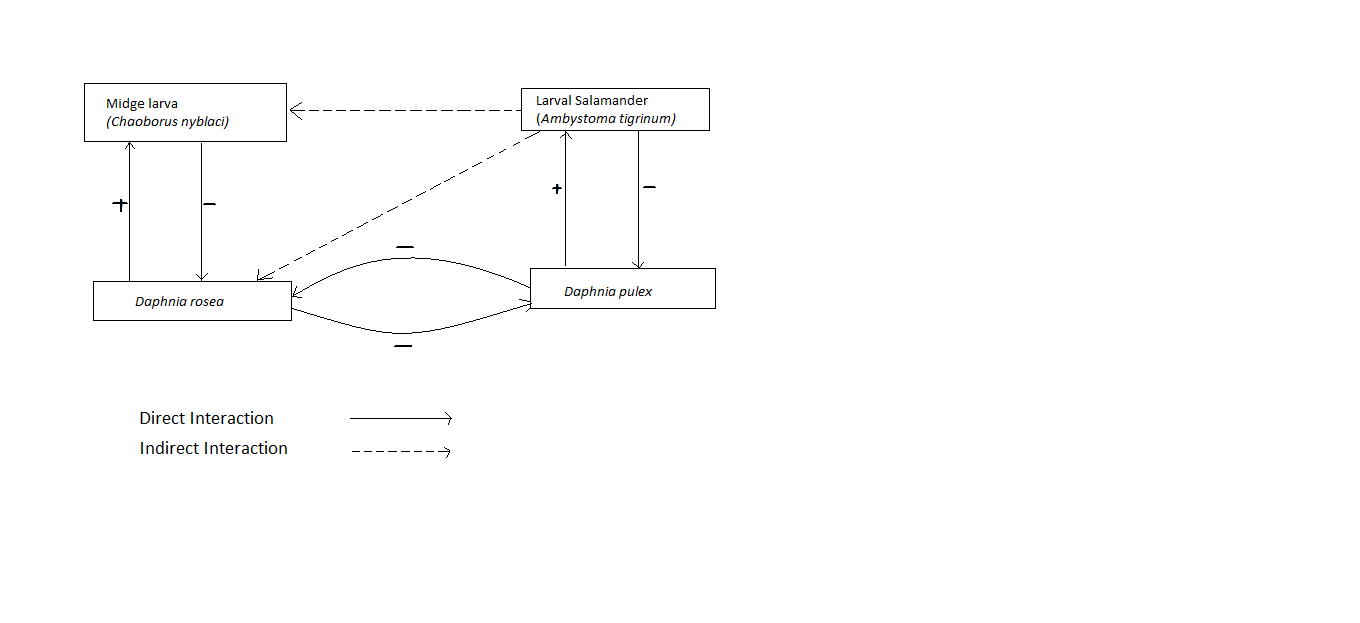Answer
405.3k+ views
Hint:The animal world depicts different types of relationships in the form of interactions. Ecological interdependence is reflected in their interactions, mainly for food, space, reproduction, and protection. These can have direct effects or indirect effects that means they can have positive and negative effects.
Complete step by step answer:The above question is based on the concept of ecological interdependence.
The effects of interactions are broadly categorized as direct (directly from one individual to another) and indirect effects (mediated through a transmitter).
Interactions have direct effects between populations of species in a community and are broadly categorized into positive, negative, or neutral interactions, depending upon the nature of the effect of the interacting organism.
In neutral interaction, interacting species have no effect on each other.
The interaction in which both participating species are benefitted is called positive interaction.
The interacting species in which one or both participating species get harmed is called a negative interaction.
As indicated by the picture, the presence of high quantities of larval lizards will restrain the Daphnia pulex creation or formation. This will show constructive outcomes on D. rosea on the grounds that D. pulex has a negative impact on it. At the point when larval lizards are available, predation lessens the populace development pace of the bigger Daphnia, D. pulex. This will encourage the concurrence of the Daphnia rosea. The two types of Daphnia for similar assets and henceforth increment in asset accessibility will build the number of midge hatchlings and larval lizards as the two types of Daphnia have beneficial outcomes. Expansion in the quantity of D. pulex would prompt a lessening in the quantity of D. rosea. This ultimately will diminish the number of midge hatchlings.
Consequently, the choices (A) Presence of high numbers of larval Salamander have an indirect effect on D. rosea and it is a positive effect.
(B) When larval salamanders are present, predation reduces the population growth rate of the larger Daphnia, facilitating the coexistence of the two species of Daphnia.
and (D) Increase in the number of D. pulex would lead to a decrease in the number of midge larvae is right.
So, (A), (B), and (D) are correct choices.
Note:The effects of interaction between a community can be direct effects or indirect effects. The receiver and donor are both affected differently according to the extent of effects. The transmitter is an important second species that plays a major role in indirect transmission. Direct interactions further lead to positive interactions (facilitation), negative interaction, and neutral interaction (neutralism).
Complete step by step answer:The above question is based on the concept of ecological interdependence.
The effects of interactions are broadly categorized as direct (directly from one individual to another) and indirect effects (mediated through a transmitter).
Interactions have direct effects between populations of species in a community and are broadly categorized into positive, negative, or neutral interactions, depending upon the nature of the effect of the interacting organism.
In neutral interaction, interacting species have no effect on each other.
The interaction in which both participating species are benefitted is called positive interaction.
The interacting species in which one or both participating species get harmed is called a negative interaction.
As indicated by the picture, the presence of high quantities of larval lizards will restrain the Daphnia pulex creation or formation. This will show constructive outcomes on D. rosea on the grounds that D. pulex has a negative impact on it. At the point when larval lizards are available, predation lessens the populace development pace of the bigger Daphnia, D. pulex. This will encourage the concurrence of the Daphnia rosea. The two types of Daphnia for similar assets and henceforth increment in asset accessibility will build the number of midge hatchlings and larval lizards as the two types of Daphnia have beneficial outcomes. Expansion in the quantity of D. pulex would prompt a lessening in the quantity of D. rosea. This ultimately will diminish the number of midge hatchlings.
Consequently, the choices (A) Presence of high numbers of larval Salamander have an indirect effect on D. rosea and it is a positive effect.
(B) When larval salamanders are present, predation reduces the population growth rate of the larger Daphnia, facilitating the coexistence of the two species of Daphnia.
and (D) Increase in the number of D. pulex would lead to a decrease in the number of midge larvae is right.
So, (A), (B), and (D) are correct choices.
Note:The effects of interaction between a community can be direct effects or indirect effects. The receiver and donor are both affected differently according to the extent of effects. The transmitter is an important second species that plays a major role in indirect transmission. Direct interactions further lead to positive interactions (facilitation), negative interaction, and neutral interaction (neutralism).
Recently Updated Pages
How many sigma and pi bonds are present in HCequiv class 11 chemistry CBSE

Why Are Noble Gases NonReactive class 11 chemistry CBSE

Let X and Y be the sets of all positive divisors of class 11 maths CBSE

Let x and y be 2 real numbers which satisfy the equations class 11 maths CBSE

Let x 4log 2sqrt 9k 1 + 7 and y dfrac132log 2sqrt5 class 11 maths CBSE

Let x22ax+b20 and x22bx+a20 be two equations Then the class 11 maths CBSE

Trending doubts
Fill the blanks with the suitable prepositions 1 The class 9 english CBSE

At which age domestication of animals started A Neolithic class 11 social science CBSE

Which are the Top 10 Largest Countries of the World?

Give 10 examples for herbs , shrubs , climbers , creepers

Difference between Prokaryotic cell and Eukaryotic class 11 biology CBSE

Difference Between Plant Cell and Animal Cell

Write a letter to the principal requesting him to grant class 10 english CBSE

Change the following sentences into negative and interrogative class 10 english CBSE

Fill in the blanks A 1 lakh ten thousand B 1 million class 9 maths CBSE




